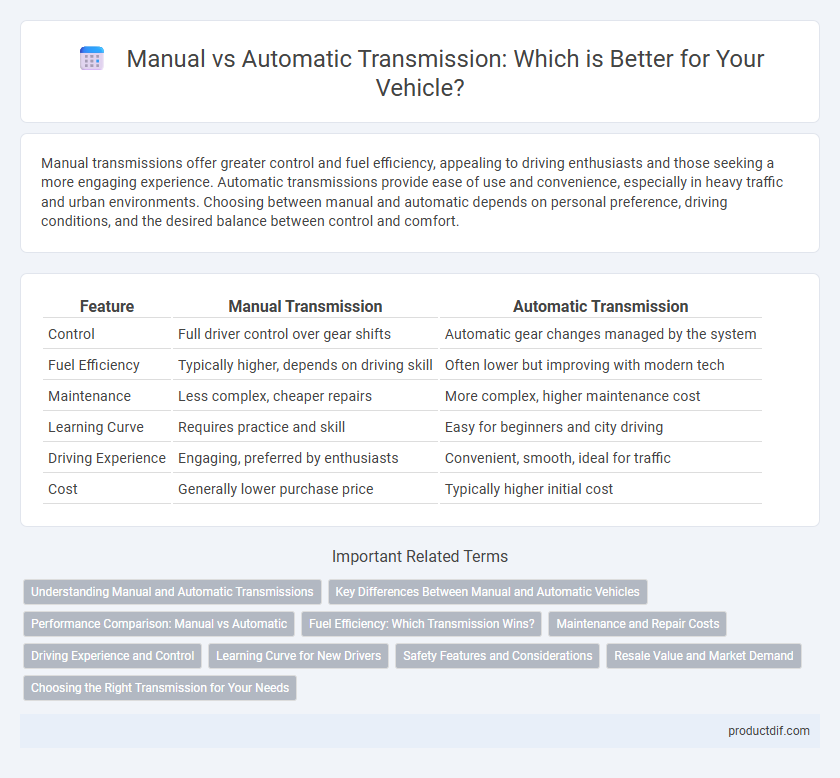Manual transmissions offer greater control and fuel efficiency, appealing to driving enthusiasts and those seeking a more engaging experience. Automatic transmissions provide ease of use and convenience, especially in heavy traffic and urban environments. Choosing between manual and automatic depends on personal preference, driving conditions, and the desired balance between control and comfort.
Table of Comparison
| Feature | Manual Transmission | Automatic Transmission |
|---|---|---|
| Control | Full driver control over gear shifts | Automatic gear changes managed by the system |
| Fuel Efficiency | Typically higher, depends on driving skill | Often lower but improving with modern tech |
| Maintenance | Less complex, cheaper repairs | More complex, higher maintenance cost |
| Learning Curve | Requires practice and skill | Easy for beginners and city driving |
| Driving Experience | Engaging, preferred by enthusiasts | Convenient, smooth, ideal for traffic |
| Cost | Generally lower purchase price | Typically higher initial cost |
Understanding Manual and Automatic Transmissions
Manual transmissions require the driver to manually shift gears using a clutch pedal and gear stick, providing greater control over vehicle performance and fuel efficiency. Automatic transmissions use a torque converter and planetary gearsets to automatically change gears based on speed and load, offering ease of use and convenience in stop-and-go traffic. Understanding the mechanical differences helps drivers choose the optimal transmission type for their driving style and conditions.
Key Differences Between Manual and Automatic Vehicles
Manual vehicles require the driver to manually shift gears using a clutch pedal and gear stick, providing greater control over engine power and fuel efficiency. Automatic vehicles use a computerized transmission system to shift gears automatically, enhancing ease of use and reducing driver workload, especially in heavy traffic. The key differences include control precision, fuel efficiency variations, and the learning curve associated with operating each transmission type.
Performance Comparison: Manual vs Automatic
Manual transmissions offer superior control over gear selection, enabling more precise acceleration and engine braking, which can enhance performance in demanding driving conditions. Automatic transmissions have improved with technologies like dual-clutch systems and continuously variable transmissions (CVTs), providing smoother and faster gear shifts that optimize fuel efficiency and power delivery. Performance differences often depend on the specific vehicle and driving scenario, with manuals favored for sportier responsiveness and automatics excelling in convenience and consistent power management.
Fuel Efficiency: Which Transmission Wins?
Manual transmissions generally offer better fuel efficiency compared to automatic transmissions due to direct control over gear shifts, enabling optimized engine performance. Modern automatic transmissions, especially those with continuously variable transmissions (CVTs) or dual-clutch systems, have significantly improved fuel economy, sometimes matching or exceeding manual counterparts. Real-world fuel efficiency depends on driving habits, vehicle model, and transmission technology, but manuals still hold a slight edge in pure fuel savings under ideal conditions.
Maintenance and Repair Costs
Manual transmission vehicles generally have lower maintenance and repair costs compared to automatic transmissions due to their simpler mechanical design and fewer components prone to failure. Clutch replacements in manual cars are typically less expensive than repairing complex automatic transmission systems, which may require fluid changes and intricate diagnostics. Over the vehicle's lifespan, manual transmissions often offer more cost-effective upkeep, although driving habits and vehicle model can influence overall expenses.
Driving Experience and Control
Manual transmissions offer enhanced control and engagement by allowing drivers to directly manage gear changes, which can improve responsiveness and fuel efficiency. Automatic transmissions provide a smoother, more convenient driving experience by eliminating the need for manual clutch operation, ideal for stop-and-go traffic and reducing driver fatigue. Enthusiasts often prefer manuals for the tactile connection and precision during spirited driving, while automatics cater to comfort and ease in urban environments.
Learning Curve for New Drivers
Manual vehicles require new drivers to master clutch control and gear shifting, which can present a steeper learning curve compared to automatic transmissions. Automatic vehicles simplify the driving process by eliminating the need to engage a clutch or manually change gears, allowing beginners to focus more on road awareness and vehicle handling. Mastering a manual transmission often enhances driver skill and vehicle control but demands more practice time for proficiency.
Safety Features and Considerations
Manual vehicles provide drivers with greater control over gear selection, which can enhance safety in challenging driving conditions such as steep inclines or slippery roads. Automatic transmissions incorporate advanced safety features like hill-start assist and electronic stability control, which help prevent rollbacks and maintain vehicle stability. Favoring automatic cars can reduce driver fatigue, thereby minimizing the risk of accidents caused by manual shifting errors.
Resale Value and Market Demand
Manual vehicles generally have lower resale value compared to automatic cars due to decreasing market demand and limited buyer interest. Automatic transmissions dominate the market, appealing to a broader audience and maintaining higher resale prices. Collectors and enthusiasts may pay a premium for specific manual models, but overall demand favors automatics, influencing long-term value retention.
Choosing the Right Transmission for Your Needs
Selecting the right transmission depends on driving habits, preferences, and vehicle use. Manual transmissions offer greater control and fuel efficiency, ideal for enthusiasts and those seeking cost savings, while automatic transmissions provide ease of use and convenience in heavy traffic or urban environments. Evaluating factors like maintenance costs, fuel economy, and driving comfort helps determine the best fit for your specific needs.
Manual vs Automatic Infographic

 productdif.com
productdif.com